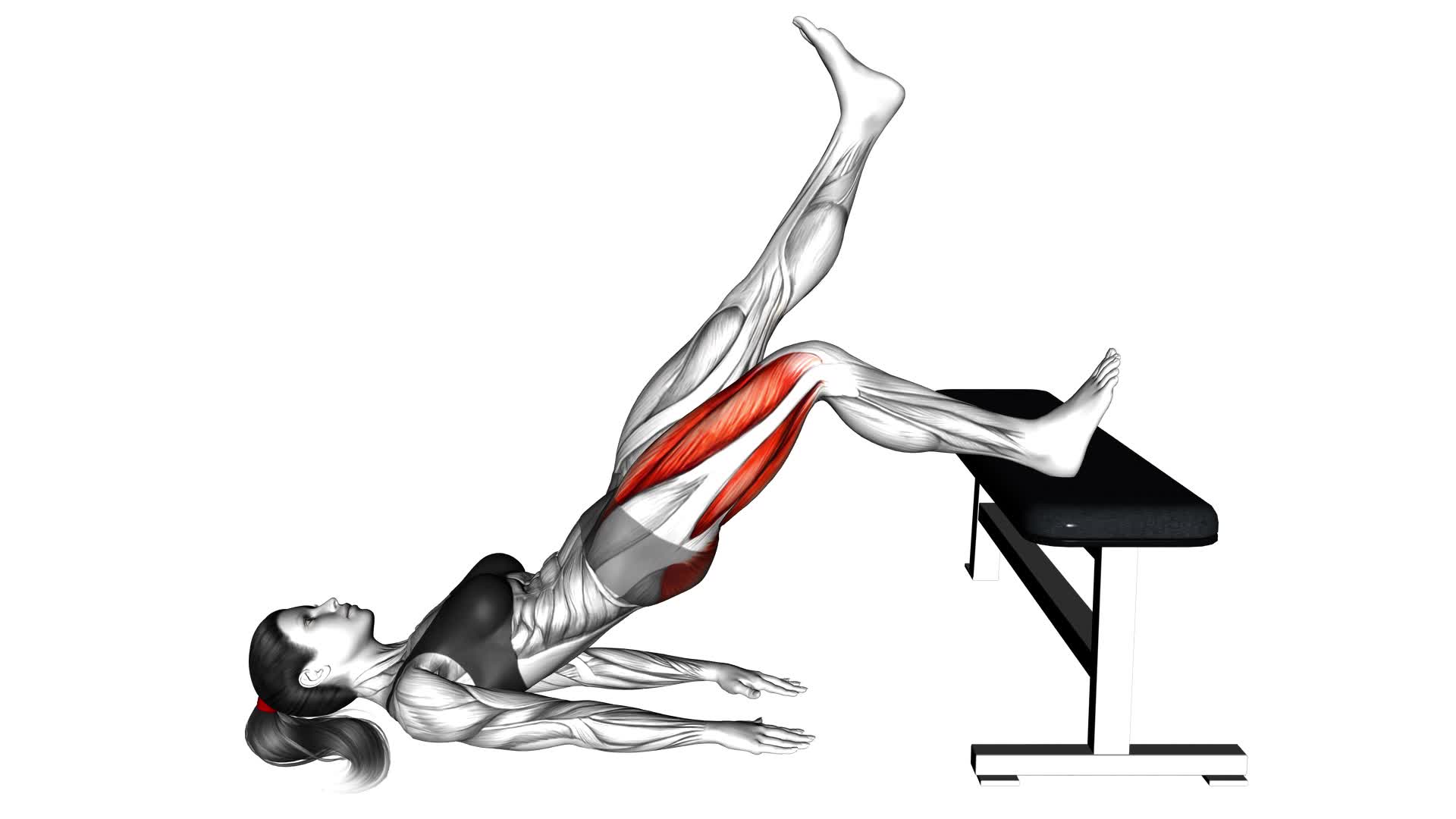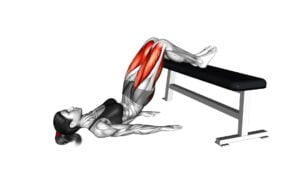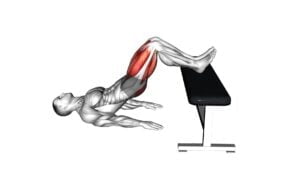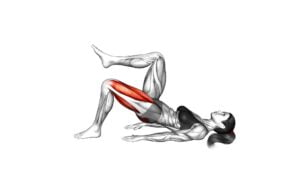Glute Bridge One Leg on Bench (female) – Video Exercise Guide & Tips

Are you looking for a challenging glute exercise that targets your muscles precisely? Look no further than the Glute Bridge One Leg on Bench.
Watch This Exercise Video
This video exercise guide and tips will provide you with the proper form and technique to maximize your results. Learn about the key muscles targeted and variations to challenge yourself.
Avoid common mistakes and get ready to see those glutes transform.
Get ready to take your workout to the next level.
Key Takeaways
- Increased glute activation
- Improved core stability
- Targets and strengthens glutes
- Engages core muscles
Benefits of Glute Bridge One Leg on Bench
You'll experience increased glute activation and improved core stability when performing the Glute Bridge One Leg on Bench exercise. This variation of the glute bridge is an effective way to target and strengthen your glutes, while also engaging your core muscles.
By performing the exercise with one leg on a bench, you're increasing the demand on your glutes and challenging their strength and stability.
To maximize the results of the Glute Bridge One Leg on Bench exercise, it's important to focus on proper form and technique. Start by lying on your back with one foot resting on a bench and the other leg extended straight in the air. Engage your core and press through your heel to lift your hips off the ground, creating a straight line from your knees to your shoulders. Hold this position for a moment, squeezing your glutes at the top, and then lower your hips back down to the starting position. Repeat on the other side.
Remember to maintain a neutral spine throughout the movement and avoid overarching your lower back. It's also important to keep your hips level and not let one side drop lower than the other.
Proper Form and Technique
To perform the Glute Bridge One Leg on Bench exercise with proper form and technique, there are a few common mistakes you should avoid.
These include not keeping your core engaged, not maintaining a straight line from your head to your knees, and not fully extending your hips at the top of the movement.
Common Mistakes to Avoid
Avoid slouching or collapsing your upper body during the glute bridge exercise to maintain proper form and technique. Slouching or collapsing your upper body can lead to ineffective results and can prevent you from maximizing the benefits of the exercise.
Another common mistake to avoid is lifting your hips too high or too low. Lifting your hips too high can put excessive strain on your lower back, while lifting them too low can reduce the activation of your glute muscles. It's important to find the right range of motion that allows you to engage your glutes effectively.
Lastly, avoid using momentum to lift your hips. Instead, focus on engaging your glutes and using controlled movements to perform the exercise correctly. By avoiding these common mistakes, you can ensure that you're getting the most out of your glute bridge exercise.
Benefits of Proper Technique
Maintain proper form and technique during the glute bridge exercise for optimal benefits.
By ensuring that you perform the exercise correctly, you can maximize gains and avoid injury. Proper form involves lying on your back with your feet flat on the ground and your knees bent.
Place one leg on a bench and keep the other leg extended in front of you. Engage your glutes and core as you lift your hips off the ground, creating a straight line from your shoulders to your knees.
Avoid arching your back or lifting your hips too high, as this can strain your lower back. By maintaining proper technique, you can target your glutes effectively and prevent unnecessary strain or discomfort.
Key Muscles Targeted
Engage your glutes and hamstrings with the Glute Bridge One Leg on Bench exercise. This exercise specifically targets the gluteus maximus, the largest muscle in your buttocks, as well as the hamstrings, which are located at the back of your thighs. By focusing on these key muscles, you can enhance glute activation and correct any muscle imbalances that may be present.
The gluteus maximus is responsible for hip extension, which is the movement of your thigh moving backward. It also plays a crucial role in maintaining proper posture and stability. By strengthening this muscle, you can improve your overall athletic performance and prevent injuries.
The hamstrings, on the other hand, are responsible for knee flexion and hip extension. They work in conjunction with the glutes to provide stability and power during various lower body movements. Strengthening the hamstrings can help prevent muscle imbalances and reduce the risk of hamstring strains.
Now that you understand the key muscles targeted in the Glute Bridge One Leg on Bench exercise, let's explore some variations that can further challenge yourself and take your glute and hamstring strength to the next level.
Variations to Challenge Yourself
To further challenge yourself and elevate your glute and hamstring strength, try incorporating these variations into your Glute Bridge One Leg on Bench exercise routine:
- Weighted Glute Bridge: Place a weighted plate or dumbbell on your hips while performing the exercise. This added resistance will increase the intensity and help you build even more strength in your glutes and hamstrings.
- Single-Leg Glute Bridge: Instead of keeping one foot on the bench, lift your other leg off the ground and extend it straight out in front of you. This modification increases the demand on your glutes and hamstrings, as well as your core stability.
- Elevated Feet Glute Bridge: Place your feet on an elevated surface, such as a bench or step, while performing the exercise. This variation increases the range of motion and activates your glutes and hamstrings in a slightly different way.
- Banded Glute Bridge: Wrap a resistance band around your thighs, just above your knees, and perform the exercise as usual. The band adds resistance and challenges your glute muscles even more.
By incorporating these progressive modifications and advanced techniques into your Glute Bridge One Leg on Bench routine, you'll continue to challenge your muscles and make progress towards your fitness goals.
Now, let's move on to the next section to learn about common mistakes to avoid.
Common Mistakes to Avoid
To avoid common mistakes and ensure proper form, focus on these key points when performing the Glute Bridge One Leg on Bench exercise.
- One common mistake to avoid isn't engaging your core throughout the movement. Your core muscles play a crucial role in stabilizing your body and maintaining proper alignment. By keeping your core tight and engaged, you can maximize the effectiveness of the exercise and prevent strain on your lower back.
- Another common mistake is lifting your hips too high or too low. To get the most out of this exercise, aim to lift your hips until your body forms a straight line from your shoulders to your knee. Lifting too high can put excessive stress on your lower back, while lifting too low can reduce the activation of your glutes.
- Lastly, make sure to keep your foot firmly planted on the bench throughout the movement. Lifting your foot off the bench can decrease the stability of the exercise and compromise your form.
By avoiding these common mistakes, you can maximize the results of the Glute Bridge One Leg on Bench exercise and target your glutes effectively.
Now, let's move on to the next section for tips on how to further maximize your results.
Tips for Maximizing Results
To maximize your results with the glute bridge one leg on bench exercise, it's important to focus on proper form techniques.
Make sure to keep your core engaged, squeeze your glutes at the top of the movement, and maintain a straight line from your shoulders to your knees.
Additionally, incorporating progressive overload strategies, such as increasing the weight or repetitions over time, can help you continually challenge your muscles and see improvements in strength and muscle tone.
Proper Form Techniques
How can you maximize your results with proper form techniques for the Glute Bridge One Leg on Bench exercise? Follow these tips to ensure you're performing the exercise correctly and efficiently:
- Engage your glutes: Prioritize activating your glutes throughout the movement by focusing on squeezing them at the top of the bridge.
- Maintain a straight line: Align your body from your shoulders to your knees, avoiding any sagging or arching in your lower back.
- Use a stable bench: Choose a sturdy bench that can support your weight and provide a stable surface for your foot.
- Explore modifications: If you find the exercise too challenging, try performing the glute bridge with both legs on the bench or using a resistance band for added support.
Progressive Overload Strategies
To maximize your results with the Glute Bridge One Leg on Bench exercise, implement progressive overload strategies. Overload progression is a key concept in resistance training techniques that involves gradually increasing the demands placed on your muscles to stimulate growth and strength gains.
There are several ways to apply progressive overload to the Glute Bridge One Leg on Bench exercise. One effective strategy is to increase the resistance by using weights or resistance bands. Start with a manageable weight and gradually increase it as you get stronger.
Another approach is to increase the number of repetitions or sets you perform. Gradually add more reps or sets to challenge your muscles further.
Additionally, you can also increase the time under tension by slowing down the movement or holding the top position for longer.
Frequently Asked Questions
How Many Reps and Sets Should I Do for the Glute Bridge One Leg on Bench Exercise?
To determine the number of reps and sets for the glute bridge one leg on bench exercise, you should consider your fitness level and goals. Generally, it's recommended to start with 2-3 sets of 8-12 reps per leg.
As you progress, you can increase the number of sets or reps to challenge your muscles further. Additionally, you can explore exercise variations like using a resistance band or adding weight to make the exercise more intense.
Can Men Also Perform the Glute Bridge One Leg on Bench Exercise?
Yes, men can definitely perform the glute bridge one leg on bench exercise. This variation of the glute bridge is beneficial for both men and women as it targets and strengthens the glutes, hamstrings, and core muscles.
Is It Necessary to Use a Bench for the Glute Bridge One Leg Exercise, or Can I Use a Different Elevated Surface?
Yes, it's possible to use a different elevated surface for the glute bridge one leg exercise. While a bench is commonly used, you can also use a step, a sturdy box, or even a yoga block. The key is to find a surface that allows your hips to be elevated and provides stability.
This exercise can be modified and adapted to suit your fitness level, so variations for beginners are also available.
Are There Any Modifications or Adaptations for Individuals With Lower Back Pain or Injury?
If you're dealing with lower back pain or injury, there are modifications you can make to the glute bridge one leg on bench exercise. These adaptations help to alleviate strain on your lower back while still targeting your glute muscles.
By reducing the range of motion or using a lower bench height, you can tailor the exercise to your needs.
This exercise is especially beneficial for individuals with weak glute muscles, as it helps to strengthen and stabilize the hips.
Can the Glute Bridge One Leg on Bench Exercise Help With Improving Posture?
Improving your posture is important for maintaining a healthy spine and preventing back pain. The glute bridge one leg on bench exercise can help with this.
By targeting your gluteal muscles, it strengthens your core and stabilizes your pelvis, leading to better alignment and posture.
Additionally, the glute bridge has other benefits like enhancing hip mobility and increasing lower body strength.
Incorporating this exercise into your routine can contribute to overall improved posture and body mechanics.
Conclusion
In conclusion, the glute bridge one leg on bench exercise is a beneficial way to target and strengthen the glute muscles. By maintaining proper form and technique, you can maximize the effectiveness of this exercise.
Additionally, incorporating variations and avoiding common mistakes will challenge yourself and prevent injury. Follow these tips to achieve optimal results and enhance your glute strength and stability.

Author
Years ago, the spark of my life’s passion ignited in my mind the moment I stepped into the local gym for the first time. The inaugural bead of perspiration, the initial endeavor, the very first surge of endorphins, and a sense of pride that washed over me post-workout marked the beginning of my deep-seated interest in strength sports, fitness, and sports nutrition. This very curiosity blossomed rapidly into a profound fascination, propelling me to earn a Master’s degree in Physical Education from the Academy of Physical Education in Krakow, followed by a Sports Manager diploma from the Jagiellonian University. My journey of growth led me to gain more specialized qualifications, such as being a certified personal trainer with a focus on sports dietetics, a lifeguard, and an instructor for wellness and corrective gymnastics. Theoretical knowledge paired seamlessly with practical experience, reinforcing my belief that the transformation of individuals under my guidance was also a reflection of my personal growth. This belief holds true even today. Each day, I strive to push the boundaries and explore new realms. These realms gently elevate me to greater heights. The unique combination of passion for my field and the continuous quest for growth fuels my drive to break new ground.







